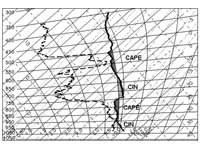CSIP-Convective Storm Initiation Project
Science Issues
Of particular interest to CSIP was a stable-layer phenomenon known as a “lid”. A lid is a layer of warm, dry air that traps air of high wet-bulb potential temperature, usually in the boundary layer, beneath potentially colder air in the middle and upper troposphere. These layers give rise to so-called Convective INhibition (CIN) and they inhibit the onset of deep convection. A lid assists in the build-up of latent instability by allowing warm, moist air to be bottled-up at low levels, thereby increasing CAPE (Convective Available Potential Energy).
For the deep convection to be triggered, the lid must be penetrated by the low-level air. This may happen through warming or moistening of the low-level air, which in turn may have a number of causes, and it is the precise prediction of the location of the penetration that is focus of attention for the CSIP modelling studies.
Possible triggers could be warming due to a relatively simple process such as the diurnal temperature cycle, but may also be due to more complicated factors such as the influence of topographical features, changes in surface characteristics, the land-sea interface, or perhaps by differential shadowing by clouds at higher levels. The onset of storms in this way is known as primary initiation, and commonly results in the formation of convergence lines which can be readily spotted on satellite images.
The strength of the lid is also of great importance. This can be affected by many things, such as differing source regions for different parts of the lid, dynamic mesoscale mechanisms that lift the lid locally, or potential vorticity anomalies associated with tropopause depressions. Lifting may cool the lid rapidly, eliminating the CIN and enabling breakthrough of ascending, moist, boundary-layer air.
Predicting the location of the initial convection outbreak can be crucial for another reason. Once the first convective storm has formed or dissipated, further convective activity in the area may be determined by secondary processes acting on the remnants of the storm: this is known as secondary initiation.
